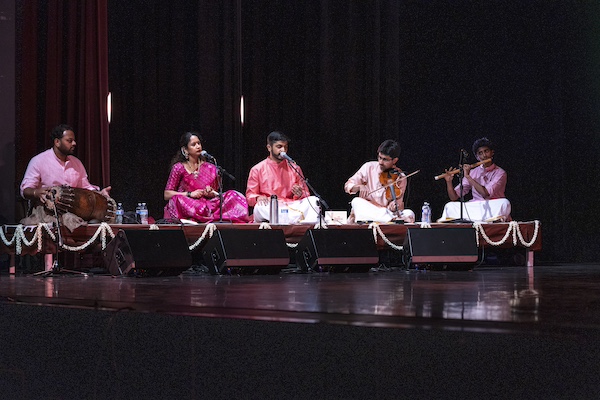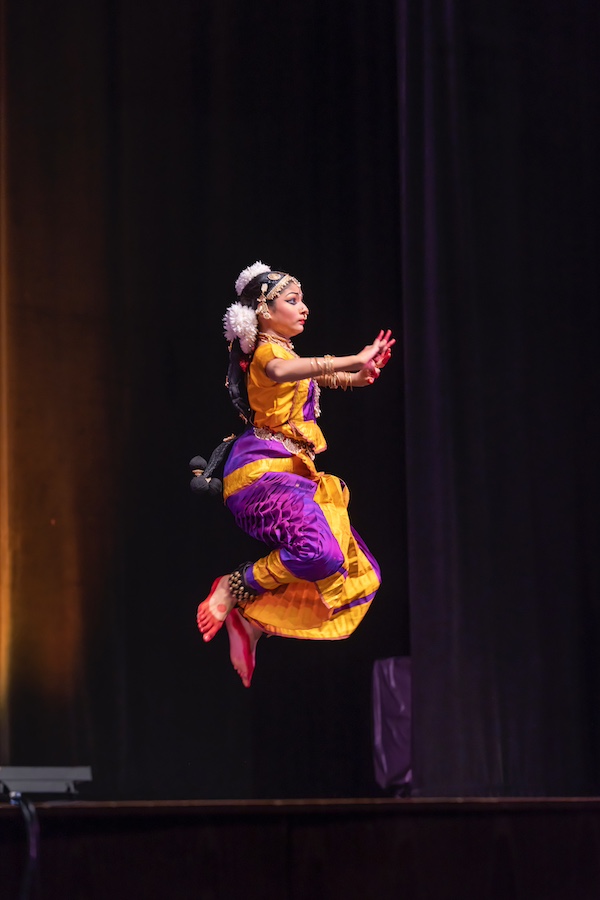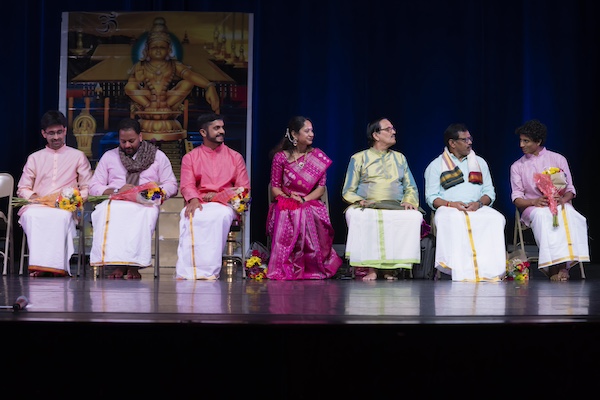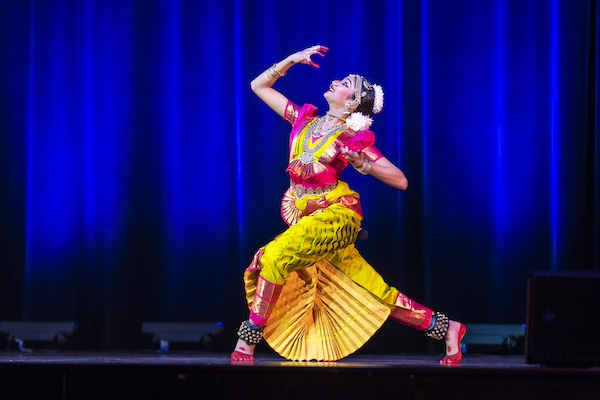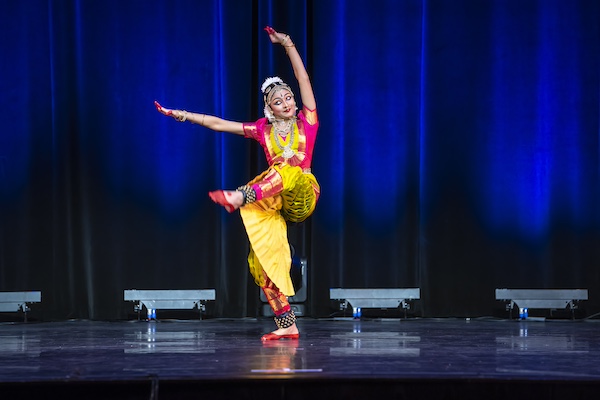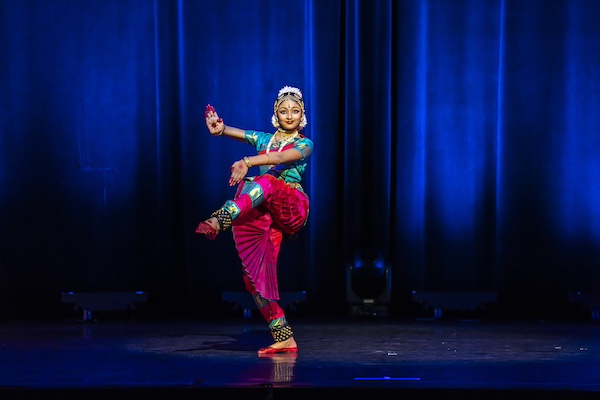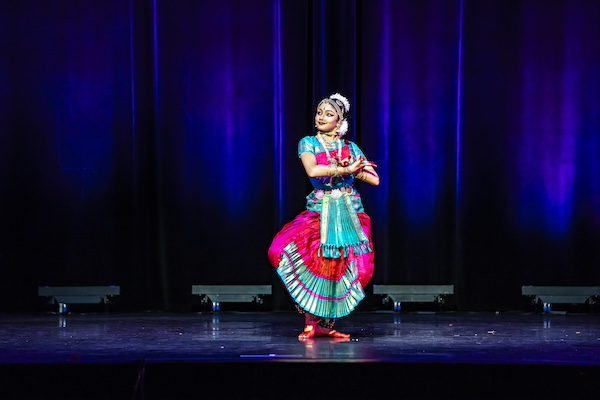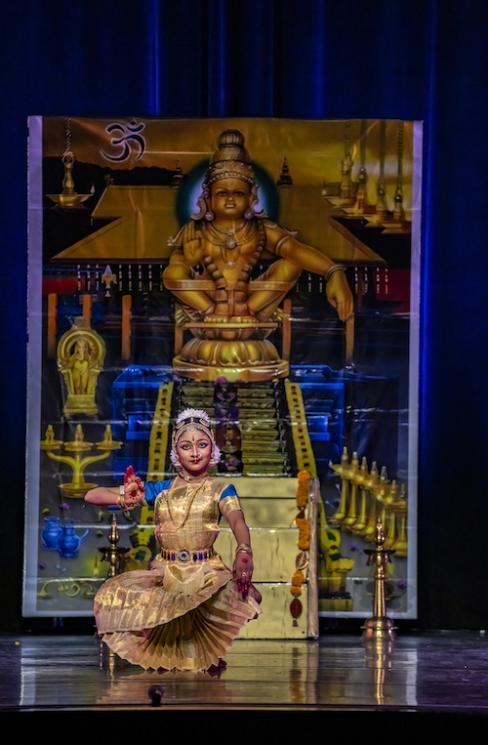Contribute
| Arangetram : Nina Kaimal |
Amrutha Ananth
09/25/2025
Attending Nina Kaimal’s Arangetram held on August 3rd, 2025 (Student of Aishwarya Balasubramanian, Arpanam Academy of Bharatanatyam) felt like witnessing a pilgrimage to Sabarimala—a path as demanding in spirit and discipline as the sacred trek itself. Just as pilgrims prepare through fasting, meditative silence, and steadfast resolve, navigating dense forests and rocky inclines to the 18 sacred steps (Padhinettupadi) leading to Lord Ayyappa, her dance unfolded as an odyssey of transformation: each piece a milestone, each movement a prayer, leading inevitably to the summit where reverence and grace are fully realized
The evening began with the orchestra’s invocation, “Umayor Bhagane,” a lyrical homage to Lord Shiva celebrating the cosmic union of masculine and feminine energies which is incidentally embodied in Hariharaputra (Lord Ayyappa), son of Shiva and Vishnu’s Mohini form. Whether by design or serendipity, this musical prelude set the spiritual tone, centering the heart and quieting the mind, echoing the devotion of pilgrims on their ascent to Sabarimala and foreshadowing the culmination of the audience’s journey in a moment of transcendent surrender.
The first dance piece, Tisra Alarippu was seamlessly interwoven with verses from Ganesha Pancharatnam, the timeless hymn by Sri Adi Shankaracharya, whose renditions by M.S. Subbulakshmi have resonated in countless hearts. Right from the outset, the dance revealed itself with intention—measured in form, yet brimming with expression. The endings of the stanzas—“Namamītham Vināyakam,” “Parātparam Nirantaram,” and “Vichintayāmi Santatam”—were accentuated by Nina’s crisp footwork, concluding in emphatic dhrigu thakas that carried both strength and piety. Invoking Lord Ganesha, the remover of obstacles and harbinger of auspicious beginnings, the piece felt like the opening step of a hallowed passage. In every movement, Nina personified the preparation and intent of a pilgrim lifting the Irumudi—the first steps taken with discipline and mindful anticipation, setting the tone for the divine and artistic voyage that lay ahead.
Next came the Jathiswaram, a ragamalika crafted by the Tanjore Quartet, showcasing intricate rhythmic and melodic interplay without abhinaya. The ragas flowed seamlessly—from the uplifting Kalyani to the soulful Begada, heroic Atana, intricate Thodi, and contemplative Surutti—mirroring the pilgrim’s traversal through shifting terrain and emotions after a dip in the holy Pamba River. The orchestra’s rendition of Atana was mesmerizing, complementing choreography rich with muzhumandis and thai hath thais, where each korvai wove effortlessly into the next with adavu variations executed with mathematical precision. Nina’s footwork struck the floor with crisp clarity, while her torso and head movements remained controlled yet fluid. After each jathi, she moved gracefully to the back of the stage, holding distinct poses—once in the elegant tripataka mudra, another in a gesture evoking the feminine form—layering visual storytelling even in moments of transition. Each step and posture felt like a measured stride along the pilgrim’s path, blending discipline, dedication, and poise, drawing the audience deeper into the unfolding journey.
The Shabdam “Devi Thaye,” composed by Madurai N. Krishnan, deepened the spiritual voyage as Nina invoked the mother goddess in all her multifaceted glory. Despite her young age, Nina displayed remarkable versatility, seamlessly shifting between emotions—her eyes shimmering with devotion, softening into maternal warmth, then flashing with divine power—echoing the goddess’s mythic acts of slaying demons, nurturing the universe, and embodying strength intertwined with grace. Through nuanced abhinaya, she invited the audience into a sanctified realm where compassion coexists with fierce protection. The choreography, deeply rooted in Bharatanatyam’s storytelling tradition, unfolded alongside ragas flowing through Kalyani, Saveri, Shanmukhapriya, and Saurashtram, enveloping the stage in shifting emotional hues—much like a pilgrim encountering sacred landmarks along the forested path, each pause inviting reflection and reverence. Nina’s measured expressions and rhythmic clarity made the audience feel as if we were journeying alongside the pilgrim, sharing in every awe-filled breath and sacred moment.
Before the centerpiece varnam, the orchestra presented a stirring interlude—Gaana Mazhai Poyigindraan Kannan, a ragamalika weaving varied melodic moods like a gentle rain shower nourishing the earth, evoking the pilgrim’s moments of quiet replenishment on the journey to Sabarimala.
The recital’s centerpiece, the Bhakthi Varnam “Pādamē Śaraṇa Adaindēn”, composed by Sri P.R. Venkata Subramanian in regal Kalyani, vividly wove episodes from the Ramayana: Rama’s mighty feat of breaking Shiva’s bow, the fierce battle with Thatakkai, and the building of the legendary bridge to Lanka. Depicting multiple characters from the epic is no easy task, yet Nina embodied each with clarity—Shabari, Ahalya, Hanuman, Thatakka, Ravana, Sita and of course Rama himself—making every abhinaya a delight to watch. The choreography’s dynamic tempo shifts and rhythmic complexity reverberated the emotional ebb and flow of heroism and divine purpose, with highlights such as “Shiva dhanushai muritthu” echoing multiple times to emphasize Rama’s unwavering strength in breaking the bow. I also enjoyed the poetic device in the charanam lines, “Padam Paniya Arul Tha, Sada Manam Kanindhurugi,” which, like the Pallavi begin with “padam”, creating rhythmic resonance across the piece. The orchestra supported her with vibrant pulses, while subtle lighting changes—golden hues marking triumph—heightened the narrative. Each korvai, each shift in tempo and expression, traced the pilgrim’s emotional passage—moments of struggle, courage, and spiritual fervor bringing the audience closer to the sense of ascending toward the divine summit.
I noticed that the Jathiswaram, the subsequent Shabdam, and the centerpiece Bhakthi Varnam all featured the ragam Kalyani, with the varnam unfolding entirely in its majestic resonance. Does the vast emotional range and serene beauty of Kalyani evoke a particular bhava, reflecting the pilgrim’s mixture of dedication, introspection, and surrender on their sacred journey, and provide such soulful continuity, seamlessly weaving together the recital’s devotional and narrative threads? I wonder.
Following the intermission came “Idadhu Padam Thooki Aadum,” a composition by Papanasam Sivan in raga Khamas, an absorbing homage to Nataraja, the celestial dancer embodying creation and dissolution. Nina’s articulate execution of the Anupallavi lines “Pada Aravaada Puliyadalaada” was particularly captivating, her movements reflecting the playful yet prayerful spirit of the verse. Each variation in hand gestures was precise and evocative, highlighting both her technical mastery and interpretive nuance. The poetic lines “Thiruvadi chilambugal galir galir yena, Thirumudi ilamathiyoli palir palir yena” were beautifully translated into movement through choreography that balanced vigorous nritta with symbolic, measured poses, while the nadai change at the charanam’s onset added delightful variation. Growing up, I had been enchanted by M.L. Vasanthakumari’s rendition—her voice seemed to breathe life into every note, with the articulation of “galir” (the ringing of anklets) capturing the transcendent resonance of rhythm itself. The rhythmic shifts in this piece, and the one that followed, echoed the pilgrim’s endurance on rocky inclines—pausing yet progressing, balancing vigor with steady commitment.
The piece “Kuzhaloodi Manamellam” in raga Kambhoji, composed by Oothukkadu Venkata Subbayyar, was a lyrical celebration of nature’s rhythms and the enchanting ambience of the forest. I was particularly struck by Nina’s execution of the Pallavi lines “Kuzhaloodi Manamellam Kollai Kondapinnum Kuraiedhum Enakedhaddi”, each iteration revealing a new dynamic. The choreography’s inventive elaborations on “Azhagana Mayil Aadavum” were a standout, enriched by the delicate interplay of violin and flute. Well-timed pauses after the “Kuzhaloodi” phrases towards the ending—moments when the music softened and Nina’s presence alone held the stage—were silent yet profoundly expressive. Here, Nina’s Bharatanatyam vocabulary truly blossomed: fluid arms, delicate wrist flicks, and gentle undulations of her upper body evoked swaying leaves and the fluttering life of the forest with graceful precision. At this juncture, it felt as though Nina, with every subtle movement, had captured the audience’s hearts and minds—as the song itself says, manam ellām kollai koṇḍāl—stealing away every heart and mind, leaving the hall spellbound.
One of the recital’s climactic highlights was the Thillana in Mohanakalyani, composed by the legendary Lalgudi Jayaraman, whose melodic genius has transcended generations. This Thillana is so beloved that, in honor of Lalgudi’s 90th birth anniversary, contemporary musicians created a “Mohanakalyani 2.0,” reimagining the classic for today’s audiences—a testament to its enduring charm and versatility. For a dancer, executing this piece is challenging, given that the beat cycle begins one count before the samam, yet Nina had fully internalized the kanakku, delivering a flawless performance. The lyrics celebrate the enchanting form of Lord Muruga, described as “Sundara Mohana Roopa”—the pure, beautiful, and captivating deity whose very presence brings bliss. Nina’s performance sparkled with precision, each korvai executed with joyous clarity, while mridangist Tarun Bangalore’s spirited percussion and lively nattuvangam propelled the energy, creating a vibrant, celebratory atmosphere. The exhilaration mirrored the pilgrim’s final ascent, a surge of anticipation and joy before reaching the last 18 steps (Padhinettupadi) at Sabarimala—where preparation, perseverance, and piety meet divine culmination.
The evening’s heartbeat deepened with the resonant Chenda Melam, performed by Melakalaratnam Kalamandalam Sivadas and disciples of the Boston Vadhya Kala Sangham. The thunderous drumming transported the audience to the vibrant festivals of Kerala, evoking the grandeur of Thrissur Pooram. Sivadas Sir’s recollections of his 25 years at the festival further enriched this cultural connection. The melam’s powerful rhythms contrasted beautifully with Nina’s serene composure throughout the recital—a dynamic balance that mirrored the pilgrim’s oscillation between exhilaration and meditative focus.
The spiritual summit was reached with the ethereal Harivarasanam in Madhyamavathi, composed by Kambangudi Kulathur Srinivasa Iyer and Konnakathu Janaki Amma. Nina’s fluid, meditative movements during “Sharanam Ayappa Swami Sharanam Ayappa”—each iteration with subtly varied choreography—embodied the pilgrim’s final surrender. The repeated Sharanam Ayappa lines were elevated by Acharya Aishwarya’s intricate dance embellishments, each concluding with detailed footwork adding layers of rhythmic precision and devotional nuance. Violinist Pranav Swaroop and flautist Skanda Rao’s interchangeable instrumentation enhanced the piece, showing how even a simple melody can attain profound beauty through subtle embellishments. A rasika would never forget K.J. Yesudas’ rendition of this gem, and on this evening, vocalist Aditya Venkatesh’s similarly vibrant voice evoked the same timeless magic. Completing the ensemble were Sri Shivadasan Ashan on the edakka and Sajith Kaimal—Nina’s father—on the chenda, making it a dream-come-true moment as father and daughter shared the stage in devotional harmony.
Nina’s expressions radiated deep inner peace, inviting the audience into a sacred silence that mirrored the pilgrim’s bliss upon sighting Ayyappa. Soft blue lighting bathed the hall in reverence, the hush of the melody enveloping the space like the closing of a temple sanctum at nightfall. In that moment, the audience shared the pilgrim’s final bliss—experiencing a collective sigh of awe and surrender. This closing was not merely an ending but a spiritual homecoming—a moment where the pilgrim’s arduous journey merged with unity, devotion, and transcendence. Nina’s graceful embodiment of this culmination left the audience suspended in reverent stillness, a shared embrace of peace, surrender, and the radiant fulfillment of her arangetram, where every step of the stage pilgrimage reached its fullest expression.
With the soulful vocals of Aditya Venkatesh, the lilting strains of Pranav Swaroop’s violin, the steady rhythms of Tarun Bangalore’s mridangam, the delicate whispers of Skanda Rao’s flute, and the precise, vibrant nattuvangam of Acharya Aishwarya Balasubramaniam, the orchestra wove seamlessly with Nina’s movements—highlighting the subtlety of each gesture, emphasizing every rhythm, and drawing the audience into the sacred journey toward Ayyappa.
Chief guest Sri Vaikom Gopalakrishnan, along with Sri Shivadasan Ashan, shared reflections that enriched the evening’s spiritual and cultural fabric. Their presence, combined with the orchestra, carefully chosen ragams, thalams, and composers, tied the narrative together, framing Nina’s journey as both personal and universal—a sacred pilgrimage of rhythm, devotion, and transformation. The sensory experience—fragrant poo kolams and flickering lamps—immersed the audience in Kerala’s sacred ambience, as though one had stepped into the heart of the pilgrimage itself.
At its heart, Nina Kaimal’s arangetram was more than a personal journey—it became a living embodiment of devotion, where every movement bridged the dancer and the audience, uniting them in a shared experience of beauty and transcendence. Through her artistry, Nina reminded us that Bharatanatyam is not only a discipline of rhythm and form, but also a profound act of communion. The evening closed not merely as a recital, but as a celebration of dedication, grace, and the timeless power of art to move hearts and illuminate spirit—a radiance that lingered long after the stage lights dimmed.
You may also access this article through our web-site http://www.lokvani.com/

